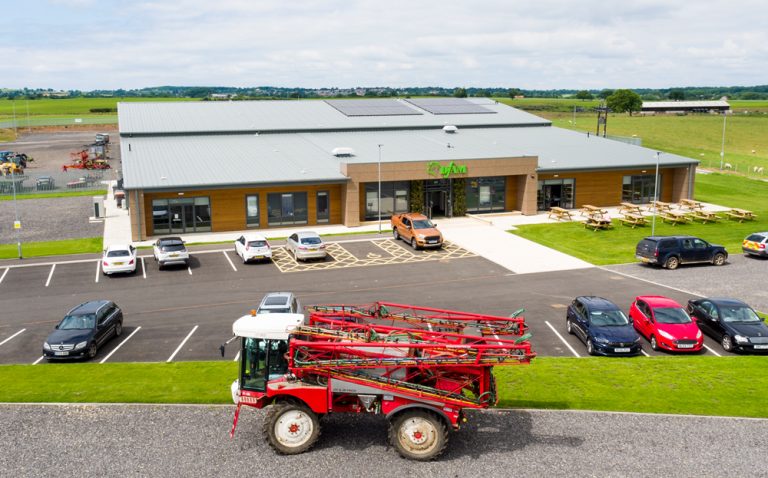11th Century
The Bishop of Durham grants Darlington the right to hold a market every Monday between Whitsun and Christmas. Because of the market, the town develops as the agricultural capital of south Durham and North Yorkshire.
Image: Durham Cathedral
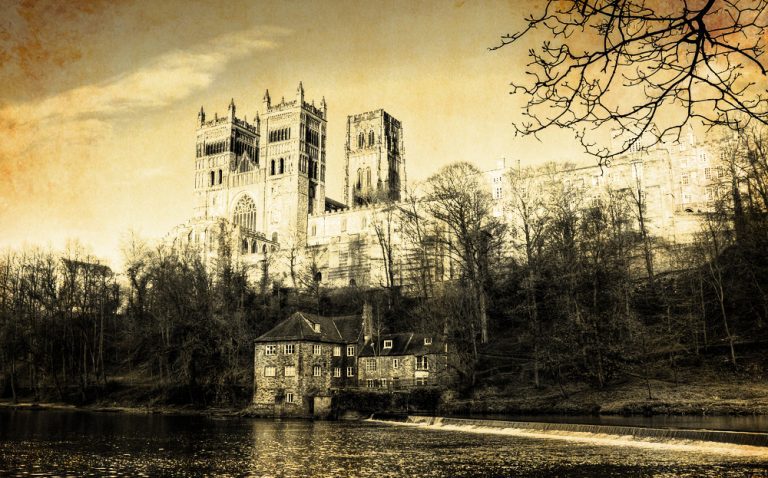
1856
The first incarnation of Darlington council takes control of the market from the bishop. Cattle are sold on High Row, geese in Prospect Place, sheep in Tubwell Row (which is known as Sheepmarket), horses in Horsemarket and Bondgate, and pigs outside St Cuthbert’s Church.
Image: St Cuthbert’s Church
cc-by-sa/2.0 – © Andrew Abbott – geograph.org.uk/p/6355021
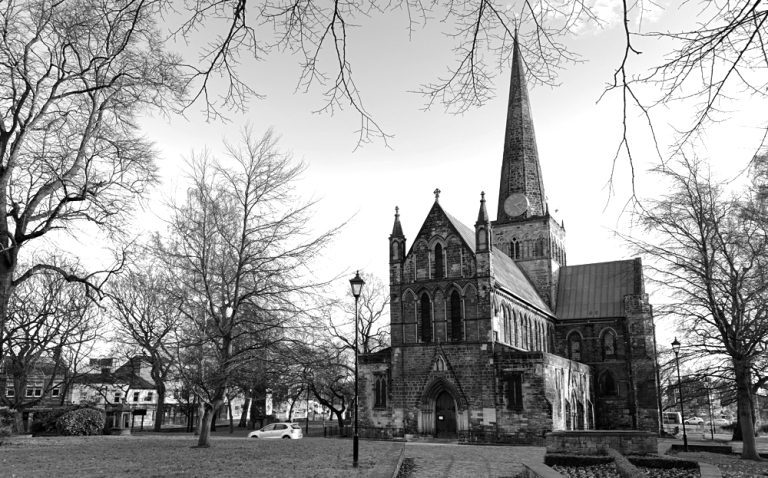
1860s
A private cattle mart is started by auctioneers Thomas and George Tarn on land leased from Lord Barnard in Barnard Street. It runs until after the First World War.
In High Row in 1862, iron posts and railings are installed to keep the cattle in pens – it is said that when these posts became redundant, they were moved to Victoria Embankment where they can still be seen lining the Skerne.
In October 1865, a cattle plague swept the North East, killing animals and halting markets.
Those scruffy beggars the drovers came from great distances driving their animals, which were portable germ factories. They distributed disease as they went. In the days before the cleanliness of the market, when the animals gormed around on High Row, those that arrived with a clean bill of health went home with a contagion.
The Darlington and Stockton Times reported that auctioneer Mr Flavell was “in the fields” of south Durham, preparing to sell stock. He would, said the paper, conduct three open air sales: Sedgefield (for farmers from Foxton, Shotton Thorp, Old Acres, Embleton, Trimdon, Fishburn, GarmondswayMoor and Morden), Ferryhill (for Chilton, Bishop Middleham, Mainsforth and Cornforth) and Bishopton (for Carlton, Redmarshall, Great and Little Stainton, Newbiggin and Stillington).
The paper said: “The jobbers will then, it is hoped, attend the sales and the risk from the disease will be reduced to a minimum.”
Image: 1865 Cattle Plague Poster
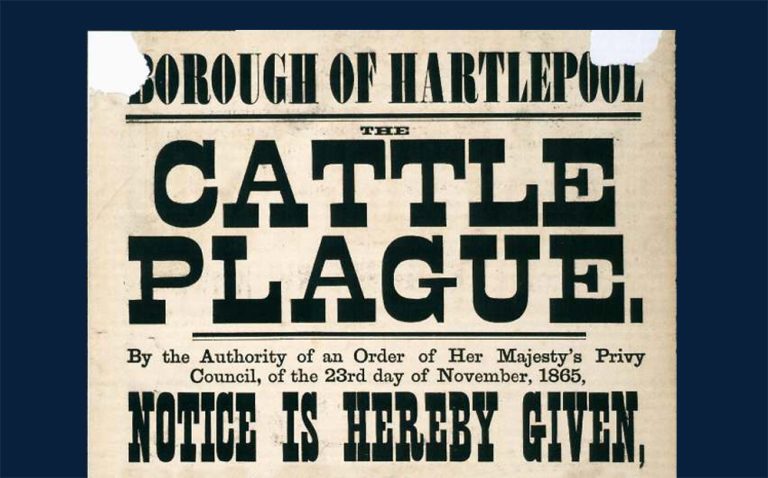
1871
A petition demands that animal sales be moved from the town centre because of the nuisance they cause. The petition is defeated by a union between farmers and town centre traders, including publicans, who benefit hugely from the trade the market brings.
Image: Busy Darlington Farmers Market
© The Northern Echo
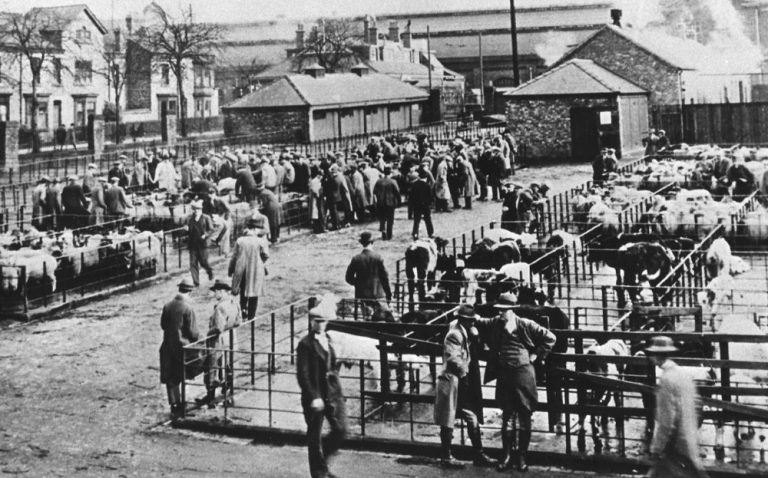
1872
The Darlington Extension and Improvement Act is passed giving the new borough council powers to control aspects of the town like the sewers and the gas supply. Section 81 of the Act says the council should “maintain and regulate” a cattle mart.
Image: Busy Darlington Farmers Market
© The Northern Echo
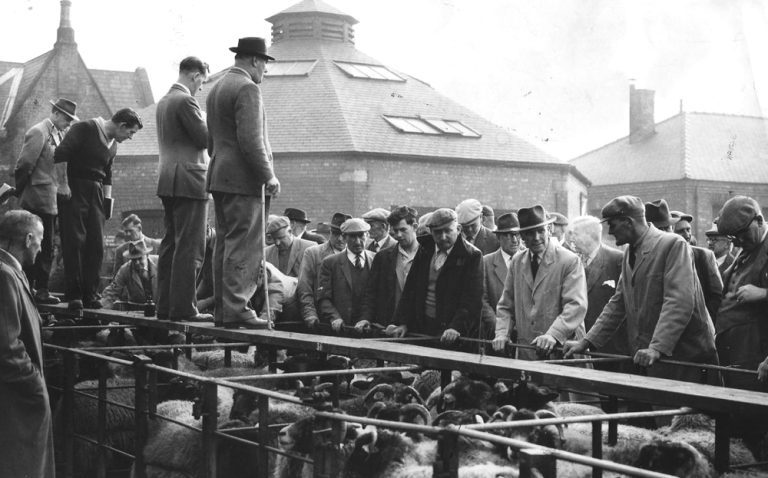
1878 - February 21st
Darlington council unanimously bans animal sales in the streets, ending 800 years of history. This was hugely controversial because of the economic impact on the town centre, although the council believed the damage was outweighed by the sanitary benefits. The mayor, Theodore Fry, presided over the meeting.
Alderman Henry Pease gave a brief report. Alderman Edward Kipling seconded the resolution, which the rest of the council carried unanimously. And that was that. The practice of holding a cattle market in the town centre streets – a practice that had begun in the 11th Century under the jurisdiction of the Bishop of Durham – was formally discontinued.
Business was transferred to a new cattle mart, which the council had built for £14,000 on pastureland near the shed that in those days served as Bank Top railway station.
It was a bitterly contested move. For centuries, Darlington’s prosperity had been built on the market, which made it the agricultural capital of Durham. As well as farmers, shopkeepers and publicans benefitted from having so many people in the town centre every Monday fortnight.
But, as the 19th Century drew to an end, the council came to the conclusion that it was not acceptable to have hundreds of cattle, horses, pigs and geese “gorming” about in High Row – which was itself part of the Great North Road – and doing what comes naturally to animals all over the cobbles.
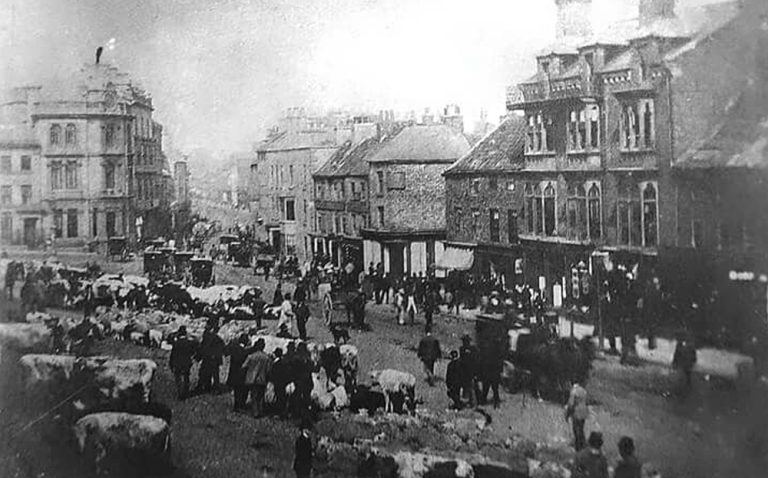
1878 - March 4th
The council’s £14,000 New Cattle Market opens on a greenfield beside Bank Top station where there is a “cattle dock” to unload the many animals that travel by train. The Darlington and Stockton Times reports: “The morning trains brought with them shoals of country folk on various errands bent; ruddy faced and long-coated dealers, plump and good tempered farmers’ daughters, and those shabbiest of shabby men – the drovers. ”Under the hammer that first morning are 11 bulls, 198 cows and heifers, 1,762 lean cattle, 115 pigs, 351 lean sheep and 60 fat sheep.
The Darlington and Stockton Times stated: “The morning trains brought with them shoals of country folk on various errands bent; ruddy faced and long-coated dealers, plump and good-tempered farmers’ daughters, and those shabbiest of shabby men – the drovers. ” Under the hammer that first morning were 11 bulls, 198 cows and heifers, 1,762 lean cattle, 115 pigs, 351 lean sheep and 60 fat sheep.
Most people seemed happy with the market, apart from those shabby drovers. They felt the top of the bank was too exposed to the northwest wind and there was nowhere for them to shelter after their long journeys in from the dales.
The Darlington and Stockton Times said: “The coldness of the situation will, of course, soon be lessened by the erection of buildings upon the corporation land that surrounds the site.
“The corner of the avenue that leads up to the cattle ground would form an excellent spot on which to erect a coffee palace, after the fashion of those in Liverpool, for apart from the tremendous business that market days would be sure to bring, it would have a great attraction for people arriving at Bank Top station. ” The paper also thought that only one class of animals was unhappy about the new location.
“Among the beasts, pity could be claimed for the pigs only, ” it reported. “At finding themselves in such clean quarters, they were distressed past the possibility of consolation; in vain their owners sought to reassure them by affectionately whipping their nostrils and twisting their tails up in corkscrew fashion: the porcine distrust of wholesomeness was not to be overcome and the creatures, presenting their least elegant aspects for public criticism, hid their offended faces from the gaze of the vulgar. ” The new mart did not have a monopoly, though. In the 1860s, the Duke of Cleveland – Lord Barnard of Raby Castle, who had a history of being contrary – leased land in Barnard Street to auctioneers Thomas and George Tarn for a fat cattle mart.
Barnard Street is off Duke Street, and the auction mart was where the telephone exchange is today.
However, the market fluctuated. It closed in 1878 when Bank Top opened, and its site was turned into allotments, but in 1893, it reopened in direct competition.
This triggered a re-run of the debate about the future of Darlington’s cattle marts.
There are complaints that on its lofty site, the mart is too exposed to the chill wind, but the D&S Times says: “The coldness of the situation will, of course, soon be lessened by the erection of buildings upon the corporation land that surrounds the site.”
It hopes that suitable services would grow up around the mart. It says: “The corner of the avenue that leads up to the cattle ground would form an excellent spot on which to erect a coffee palace, after the fashion of those in Liverpool, for apart from the tremendous business that market days would be sure to bring, it would have a great attraction for people arriving at Bank Top station.”
Instead, residential terraces spring up around it, planting the seeds of conflict.
Image: New Cattle Market Sales Ring
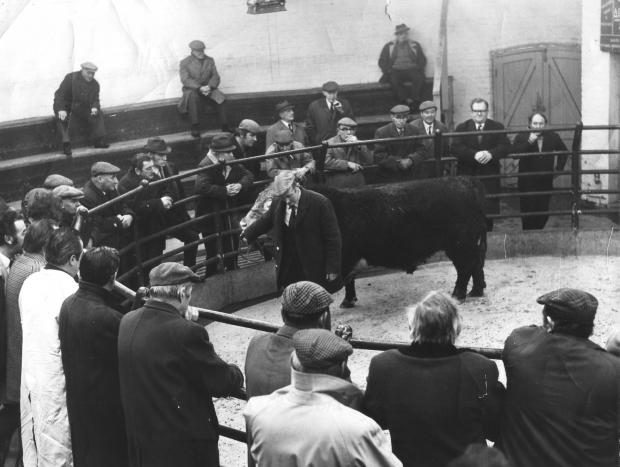
1887
The Darlington Farmers’ Auction Market Company (DFAM) is formed to run the auction on the site leased from the council. The new mart’s first neighbour was Waverley Terrace, which must have been completed shortly after Bank Top station opened in 1887.
Image: Bank Top Train Station
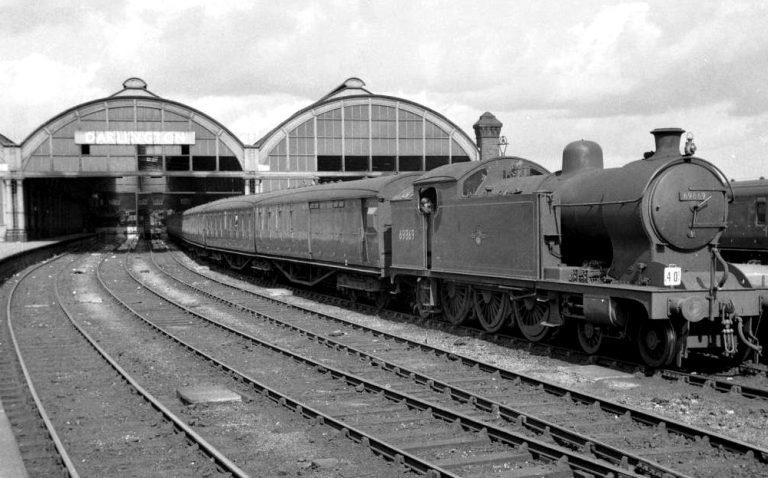
1910
In 1910, when the council acquired Feethams field, where the bus station is today, there was a Tescostyle discussion over locating the mart there. The First World War intervened. Afterwards, it was decided to concentrate once and for all on the Bank Top site. Barnard Street closed.
1927 - April 9th
Using an inscribed silver key, Mayor John George Snaith – himself a butcher who had fingers in many business pies – opened the refurbished market on April 9,1927. He spoke of the town’s hopes for the market – it now contained two banks to accelerate transactions – but he also presented some revealing figures. In 1868, 69,405 animals were sold in Darlington. In 1926, 42,700 were.
The council has spent £7,525 turning it into “one of the most commodious and up-to-date markets in the north”, which even has two banks on site. Auctioneer William Bainbridge sold the first shorthorn bullock, weighing 14¾ hundredweight, from Great Burdon, to Charles Johnson, of Skinnergate, for £35.80. He sold the first pig, bred by George Harrison, of Gainford, for £18 10s to renowned butcher GH Zissler.
And so the cattle market has stayed on its spot for the next 130 years. Streets of housing have grown up around it, and they have, as is well documented not always rubbed along happily.
1955
The first voices saying that the mart, located in a tight residential district, is in the wrong place are heard. The voices grow louder as the century progresses, but equally there are the voices of local traders who want it to stay. By the 1980s, farmers, whose increasingly large wagons struggle with access, do not disagree with a proposed move – but where to, and who will foot the bill? The council estimates it will cost a prohibitive £3m to build a new mart, and yet it has a statutory duty created by Section 61 of the 1872 Act of Parliament to provide a market.
Images: Darlington Auction & Farm Wagons in Darlington Town Centre

1990s
A plan to move the mart to Morton Palms falls through in 1990 when the price of land rises sharply –Morrisons supermarket will soon be built on the planned site. The council votes unanimously to close the mart, and it petitions Parliament to have the 1872 Act repealed. However, the National Farmers’ Union says that 1,000 farmers from the Scottish borders into North Yorkshire will suffer without a market, and so a House of Lords select committee rejects the petition in June 1991.
The issue takes a desperately sad turn in August 1992 when local lad Jack Hunter, 11, falls through the mart roof to his death. Labour MP Alan Milburn joins Labour councillors in highlighting safety fears and calling for a move.
DFAM has acquired 55 acres of land off Neasham Road (opposite where the football stadium will be built) on which it wants to build 350 houses to finance the construction of a new market. However, the Department of the Environment (DoE) blocks the houses from being built on the greenfield site.
Darlington council grants DFAM permission to build a new market on Holdforth Grange on the Hurworth side of the A66, near the football stadium. Villagers allege that the council has broken its own procedures in its hurry to solve the problem, and appeal to the DoE which blocks the move.
The project is now in stalemate. In 1995, there’s a proposal to amalgamate with Barnard Castle mart and move to Scotch Corner, but this is blocked by Yorkshire fears for what will happen to marts at Leyburn and Hawes.
21st Century
Stephen Aitken joins DFAM just after the turn of the Century, a refreshing and renewed drive to relocate fast develops under his leadership and guidance, the rumblings within the company are that ‘the move will happen’.
Councillors continue to press for the mart to move, and in June 2006 the first plans for a £14m agricultural centre at Humbleton Farm, between Burtree Gate and Heighington are floated. In 2010, the council goes against the advice of its own planning officers and grants DFAM permission to build houses on Neasham Road to finance the construction.
Progress continues to be hard, and in April 2015 there’s another tragedy, when Kyle Hull falls through the mart roof.
This seems to galvanise people. With the involvement of Jenny Chapman MP and ward councillor Cyndi Hughes, hundreds of people sign petitions demanding that the market be moved, although perhaps the key moment comes when the council agrees to give DFAM a bridging loan and buys Neasham Road from it in 2018.
This enables construction at Humbleton to begin, but the coronavirus pandemic puts the move to the new site on hold until…
Image: Stephen Aitken
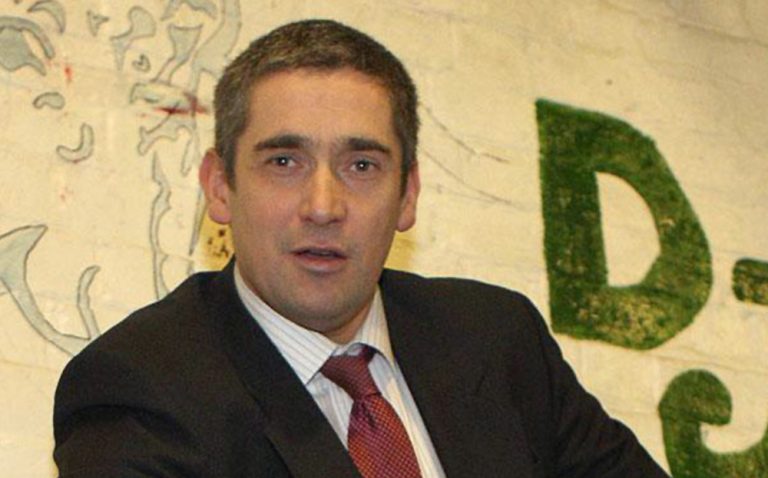
2020 - September 17th
After 142 years, the last sale is held at the Bank Top, with the last bullock belonging to John Hall of Burdon Grange selling for £3,028 to the Penny family of Leeds who have been mart customers for more than a century.
The official mart report for the last sale makes mention of the former managing director who died in 2013. It says: “A fitting tribute was paid before the final beast was offered, remembering the late Stephen Aitken. A warm round of applause left very few dry eyes around the ring as the now imminent, and long-awaited move, makes Stephen’s dream a reality.”
Image: Darlington Farmers Market Closes
© The Northern Echo
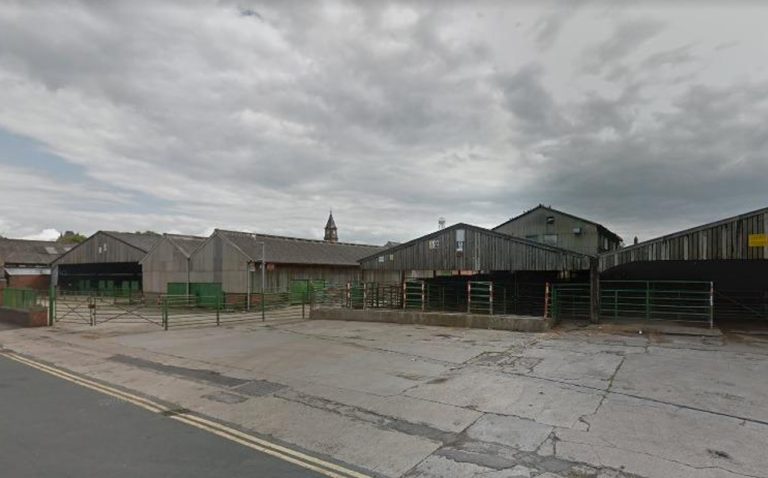
2020 - September 21st
The first sale is held at Humbleton Park, and for the first time since the 11th Century, there will be no livestock sale in Darlington town centre.
So begins a fresh chapter in a very long history, for records of a cattle mart in Darlington go back to the 11th century, when the market rights were vested in the Bishop of Durham. The site on Clifton Road operated from March 4, 1878, when Mr Theo Fry, the Mayor of Darlington, sanctioned the market’s move from the town centre to the ‘New Cattle Market’, which cost £18,000 – the equivalent of more than £2 million in today’s money by some calculations. The opening day in 1878 witnessed an entry of 988 cattle and 402 sheep. In comparison in 2020 the opening two-day sales auctioned 546 Cattle and 3194 Sheep.
Image: New Darlington Farmers Market Opens
